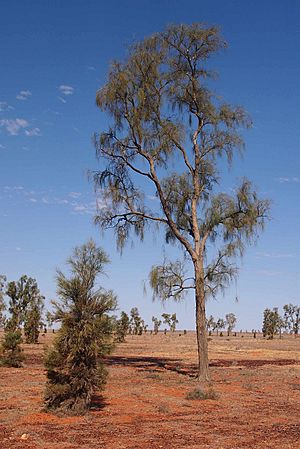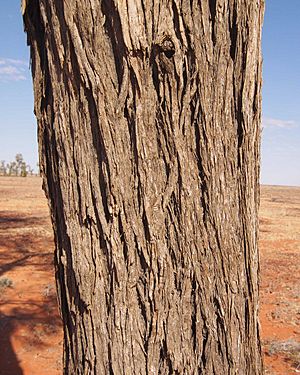Birdsville wattle facts for kids
Quick facts for kids Birdsville wattle |
|
|---|---|
 |
|
| Adult A. peuce | |
| Conservation status | |
| Scientific classification | |
| Genus: |
Acacia
|
| Species: |
peuce
|
 |
|
| Occurrence data from AVH | |
| Synonyms | |
|
Racosperma peuce (F.Muell.) Pedley |
|
Acacia peuce, also known as Birdsville wattle, waddy, waddi, or waddy-wood, is a special tree found only in central Australia. It is a unique part of the Australian landscape.
Different Indigenous Australian groups have their own names for this tree. The Arunda people call it Aratara. The Pitta Pitta people know it as Kurriyapiri and Red Ochre Father. The lower Arrernte people call it Arripar.
Contents
What Does Acacia peuce Look Like?
This smooth, hairless tree can grow very tall, reaching up to 15 to 18 meters (about 50 to 60 feet) high. It has short branches that stick out sideways and droopy, hanging smaller branches. These branches are covered in long, thin, needle-like leaves called phyllodes. These special leaves help the tree survive in very dry places.
The Acacia peuce has a unique shape that makes it look more like a sheoak or a conifer (like a pine tree) than a typical wattle.
Wood and Bark
The wood of this tree is incredibly hard and heavy. The center part of the wood, called the heartwood, is a dark purple color. The trunk and branches are covered with rough, grey-brown bark.
Leaves and Growth
The dull green leaves are usually 8 to 12 centimeters (about 3 to 5 inches) long. Some can even grow as long as 40 centimeters (about 16 inches)! They are only about 1 millimeter (0.04 inches) wide and have four sides.
This tree grows very slowly. It can live for a long time, often over 200 years, and some trees are thought to live for more than 500 years! Young trees, called saplings, look like small conifer trees. It can take them about three years just to grow 1 meter (about 3 feet) tall.
Flowers and Seeds
The flowers of Acacia peuce grow in round clusters. These clusters are supported by small stalks that are 12 to 15 millimeters (about 0.5 to 0.6 inches) long. The flowers are a pale yellow color. They usually appear in autumn and spring, especially after heavy rain.
After the flowers bloom, the tree forms long, flat, papery seed pods. These pods contain large, flat seeds.
How Was Acacia peuce Named?
The Acacia peuce was first officially described by a botanist named Ferdinand von Mueller in 1863. He wrote about it in his book Fragmenta Phytographiae Australiae.
Later, in 1986, another botanist named Leslie Pedley gave it a different scientific name, Racosperma peuce. However, Acacia peuce is the name most commonly used today.
This tree is closely related to other Australian wattles like the A. crombiei and A. carneorum.
Where Does Acacia peuce Live?
Scientists believe that Acacia peuce used to be found across a much larger area of central Australia about 400,000 years ago, when the climate was wetter. Today, it mostly lives in only three main areas. These areas are separated by the Simpson Desert, which is slowly expanding.
In the Northern Territory, these trees are found in the Mac Clark (Acacia peuce) Conservation Reserve. The other two main groups of trees are near Boulia and Birdsville in Queensland.
These trees grow on flat, dry plains that usually get less than 150 millimeters (about 6 inches) of rain each year. They can be found on sandy areas over rocky ground or clay slopes. They also grow between sand dunes or on flat areas near temporary rivers that only flow after rain. The soil where they grow can sometimes be salty or have a lot of gypsum (a type of mineral).
Even though the trees are spread out over a large area of about 74,000 square kilometers (about 28,600 square miles), the actual space they occupy is much smaller, only about 400 square kilometers (about 150 square miles). There are about 76,000 individual trees in total.
What Lives Around Acacia peuce?
Acacia peuce trees often grow together in groups, forming open woodlands. Other plants that grow nearby include shrubs like Rhagodia, Atriplex, Grevillea stricta, Atlaya hemiglauca, and Hakea leucoptera. You can also often find grasses like Astrebla and Eragrostis growing with them. Along temporary waterways, they might grow alongside Eucalyptus coolabah trees.
How Is Acacia peuce Used?
Uses by People
Indigenous Australians traditionally used the very hard and heavy wood of the Acacia peuce to make clubs, which they called waddy.
Early pastoralists (people who raised livestock) also used the timber from these trees. They found it was very strong and resisted termites, so they used it to make durable fence posts and stockyards. If a tree was cut down for posts, the stump would often grow new shoots vigorously.
Habitat for Animals
The Acacia peuce tree is important for many animals. It is a home for different types of butterflies and their young (larvae). It also provides a safe place for birds, from large grey falcons to small desert finches.
While insects often chew on the leaves, young Acacia peuce trees used to be eaten by large grazing animals like cattle and even ancient creatures like the diprotodon.





